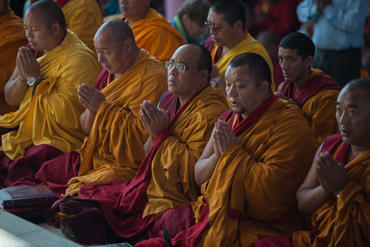Tashi Lhunpo, Bylakuppe, Karnataka, India, 24 December 2015 - At Tashi Lhunpo there are three major areas where people are sitting to listen to the teachings and observe what is happening on big video screens. One large group of people is sitting directly in front of the monastery, facing His Holiness. Another large group is sitting adjacent to the monastery to the east and a third group is slightly behind and to the west of the monastery. All three areas are covered by awnings to protect people from the sun. In the period between people taking their seats and the teachings beginning, monks from all the major monasteries are engaging in debate.
The teaching sites remain in relatively good order because there are cleanup teams of monks from the monastery who clear up all the empty water bottles, which they sell on for recycling.
Although the prayers are much the same, principally the Lam Rim Lineage Prayer at the beginning and the Lam Rim Dedication Prayer at the end. They sound different from day to day because Chant Masters from different monasteries are taking it in turns to lead the recitation. The prayers culminate in the offering of the mandala and three representations of the body, speech and mind of enlightenment. Today, the Gyumey Khenpo made the offering, followed by Thupten Zopa Rinpoche.
Subsequently, His Holiness the Dalai Lama announced that Zopa Rinpoche had approached him with a request for prayers for the people of Nepal. This year the trouble they have faced as a result of the April earthquakes has been compounded by a blockade of the border with India. His Holiness said:
“Tibet and Nepal have had neighbourly relations since the time of Songtsen Gampo, 33rd King of Tibet. The murals in the Jokhang were painted by Nepalese artists and we have many other art works that are of Nepalese origin. Many people died and many more lost their homes in the earthquakes. I was pleased to hear that monks and nuns worked hard to help people where they could. There is not a lot those of us outside can do. I did make a donation to the relief fund. When, as now, it’s beyond our ability to do anything more practical, we can only pray that the Nepalese people’s sufferings will be relieved.
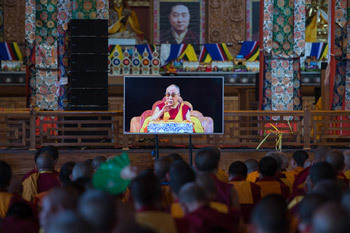
|
Members of the audience watching His Holiness the Dalai Lama on a TV monitor in the Tashi Lhunpo Temple during his Lam Rim Teaching in Bylakuppe, Karnataka, India on December 24, 2015. Photo/Tenzin Choejor/OHHDL
|
“We have all gathered here not to do business or for entertainment, but to listen to the Dharma and the focus of the texts at the moment is altruism and compassion. We are talking about generating the awakening mind of bodhichitta for the sake of all sentient beings. Having done so, we invite all sentient beings as our guests. So, when our neighbours are suffering so much I request all of you to make fervent prayers on their behalf.”
His Holiness read from Zhamar Pandita’s ‘Treatise’, which described how to train in the six perfections to ripen your own mindstream, beginning with generosity and the giving of material things, the giving of Dharma and the giving of fearlessness. He said:
“With all these practices, don’t expect immediate results, but don’t let up. And when you feel tired, take a break; it’s important to keep up your enthusiasm.”
Switching to ‘Liberation in the Palm of your Hand’, he commented:
“Most of our problems are self-created. This kind of karma occurs when we take a short-sighted view driven by our fundamentally self-cherishing attitude. What is good in our lives is related to our sense of altruism. We forget that we are dependent on other beings. Other beings are kind to us. If and when we eventually achieve liberation or enlightenment, it will have been in dependence on others.”
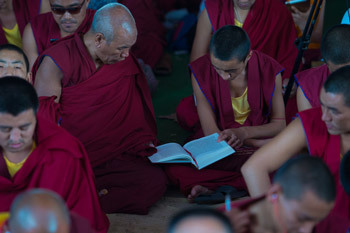
|
Two monks sharing a text as they follow His Holiness the Dalai Lama's Lam Rim Teaching at Tashi Lhunpo Monastery in Bylakuppe, Karnataka, India on December 24, 2015. Photo/Tenzin Choejor/OHHDL
|
His Holiness commended the ‘Eight Verses for Training the Mind’, the ‘Three Principles of the Path’ and ‘Praise for Dependent Arising’ as giving succinct advice along these lines. He said that he’d found it useful to memorize and regularly recite these texts. He further suggested that if you want to be happy, there is no better than cultivating the practice of giving and taking. He cited verses from Nagarjuna’s ‘Precious Garland (Ratnavali)’ as a source of inspiration:
May sentient beings be as dear to me as my own life,
And may they be dearer to me than myself.
May their ill deeds bear fruit for me,
And all my virtues bear fruit for them.
As long as any sentient being
Anywhere has not been liberated,
May I remain [in the world] for the sake of that being
Though I have attained highest enlightenment.
And another from Shantideva’s ‘Guide to the Bodhisattva’s Way of Life (Bodhicharyavatara)’:
Just like space
And the great elements such as earth,
May I always support the life
Of all the boundless creatures.
Returned from lunch, His Holiness took up ‘Liberation in the Palm of your Hand’ once more and read from the section headed, 'Converting unfortunate circumstances into a path to enlightenment'. There was a gusty wind that at one point picked up and scattered pages from His Holiness’s text. Ling Rinpoche was immediately on his feet to catch them. His Holiness remarked:
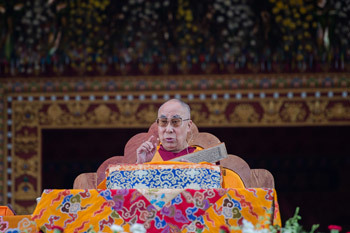
|
His Holiness the Dalai Lama during his Lam Rim Teaching at Tashi Lhunpo Monastery in Bylakuppe, Karnataka, India on December 24, 2015. Photo/Tenzin Choejor/OHHDL
|
“No phenomenon ultimately exists by itself, but it is this misconception that gives rise to attachment and other disturbing emotions. Fear arises from our sense of self-cherishing. Meditating on emptiness can counter both of these misconceptions.”
‘Liberation in the Palm of your Hand’ contains a special method that combines the two practices for generating the awakening mind of bodhichitta, the seven point cause and effect approach with exchanging self and others. Beginning with equanimity, it continues with seeing sentient beings as having been your mother, remembering their kindness, as well as the kindness of all sentient beings, wishing to repay their kindness, and so on.
His Holiness mentioned another verse he is fond of reciting, it comes right at the end of Nagarjuna’s ‘Fundamental Wisdom (Mulamadhyamakakarika), but he likes to adapt it, so instead of saying “I prostrate to Gautama...” he says:
May I be blessed by Gautama?
Who, through compassion,
Taught the exalted Dharma,
Which leads to the relinquishing of all views.
When the 1st Dalai Lama was old, he grumbled that it was time to go and one of his disciples said, “And when you do, you’ll be going to Amitabha’s Pure Land. Gendun Drup replied that he had no wish for such a result, he wanted to come back to somewhere he could help others who are suffering.
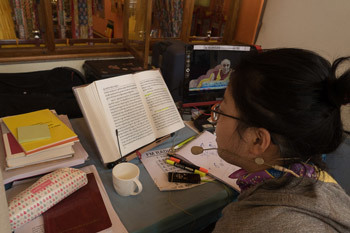
|
The Korean language interpreter, one of 12 languages available, working during the fifth day of His Holiness the Dalai Lama's Lam Rim Teaching at Tashi Lhunpo Monastery in Bylakuppe, Karnataka, India on December 24, 2015.
Photo/Tenzin Choejor/OHHDL
|
Noting that the Vinaya instructs that a Buddhist should not teach unless he or she is requested to do so, His Holiness contrasted this with the way some Christian missionaries impose their teachings without any by your leave. He feels there is a need to show each other more respect. He recalled visiting a soup kitchen in Australia run by his old friend Rev Bill Cruise who once introduced him as “the Dalai Lama, who is a very good Christian.” When it came to His Holiness’s turn to speak he returned the compliment and referred to Cruise as a good Buddhist.
His Holiness went on to comment on stories he hears of Lamas who behave badly, in the West and in China, being driven primarily by a desire for money and sex. He told one Chinese who complained about it to him that there wasn’t much he could do from India. He encouraged students to be vigilant in examining teachers, both in terms of their qualification, but also in terms of their demeanour and comportment. He remarked that the Nalanda tradition is precious and this would be one of the ways of defending it.
The next topic in the text, which we’ll reach tomorrow, is patience.
